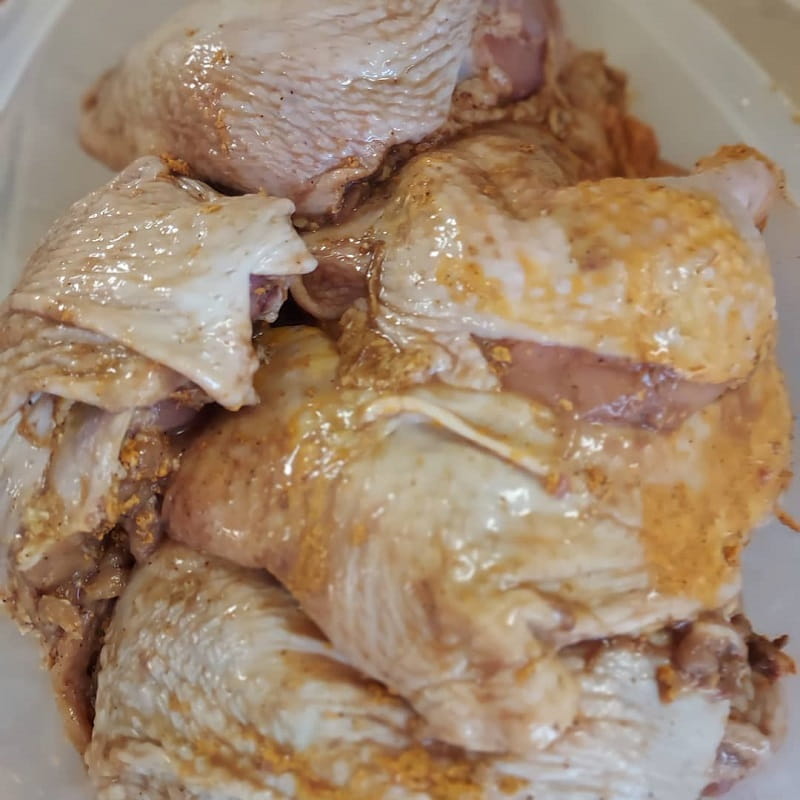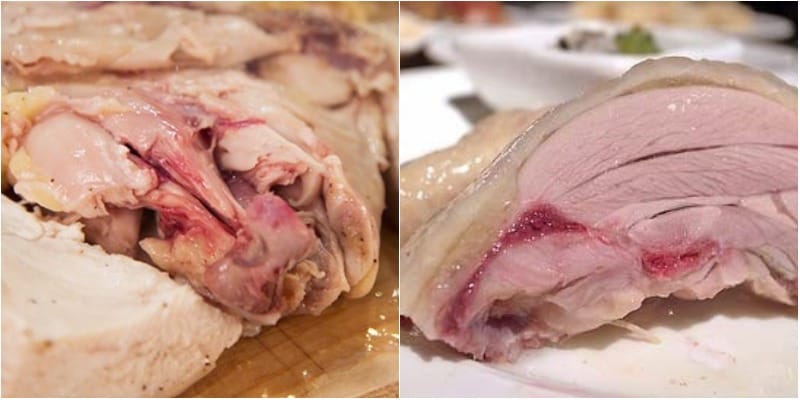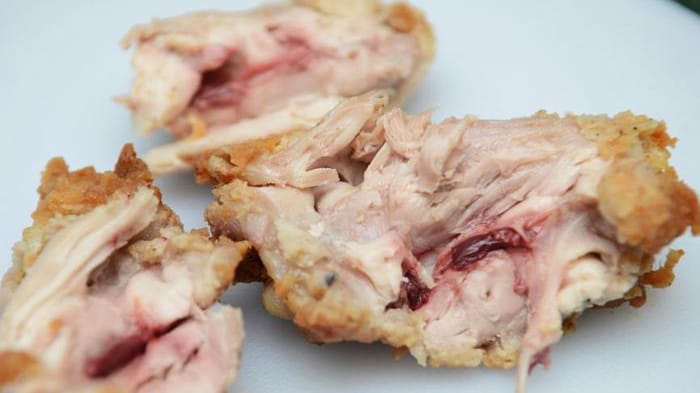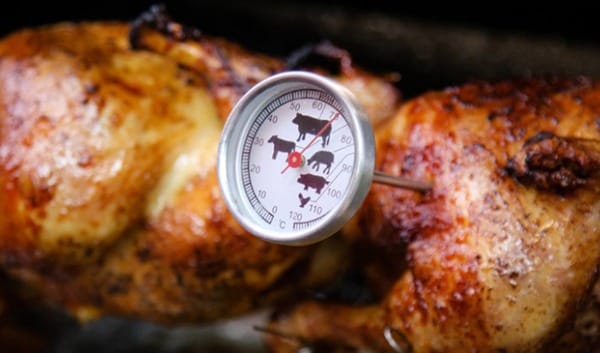Undercooked chicken is a cause for concern around the world as it poses a number of health hazards. Consuming raw or undercooked chicken can lead to serious illnesses such as salmonella, campylobacter, and listeria. Many people may assume that they can easily judge if the chicken is cooked properly simply by looking at it. However, this is not always the case, as undercooked chicken may not look uncooked. In this article, we will explore the signs and symptoms of undercooked chicken that you should be aware of to keep yourself and your loved ones safe from harmful bacteria. So, what does undercooked chicken look like? Read on to find out.
Why Knowing How To Tell If Chicken Is Undercooked Important?

As a home cook, you want to ensure that the chicken you serve your family is cooked properly. Knowing how to tell if the chicken is undercooked is essential to cooking. After all, undercooked chicken can cause food poisoning. It can also have a negative effect on the flavor of the dish.
You can look for several signs to determine if the chicken is undercooked. The most obvious one is the color. Raw chicken has a very pale, almost translucent look. When it is cooked, it should be a nice golden brown color. If the color of the chicken is still pale, it has not been cooked long enough.
The second sign to look for is texture. Raw chicken is soft and tender. When cooked, it should be firm and not mushy. If the chicken feels soft or looks wet, it has not been cooked long enough.
Finally, the smell of the chicken is another good indicator of whether it is cooked properly. Raw chicken has a strong, unpleasant odor. When cooked, it should have a very mild smell. It is likely undercooked if the chicken smells off or has a sour smell.
What Does Undercooked Chicken Look Like?
If someone is unsure whether their chicken is undercooked, there are a few things to look for. The undercooked chicken will appear raw and pink, both inside and outside. Sometimes slightly undercooked chicken looks translucent or shiny, especially around the edges. However, a simple rule of thumb is that cooked chicken will turn white on the outside and opaque all the way through.
Additionally, the undercooked chicken will likely have a metallic taste. One should also pay attention to the meat’s color and the juices coming out of the chicken. The chicken may not be fully cooked if the meat and juices are not completely white. It is always best to use a meat thermometer to ensure the chicken is cooked to the correct temperature. People can avoid undercooked chicken and enjoy a delicious and safe meal by taking these steps.
What Happens Are Eating Undercooked Chicken?
When you eat undercooked chicken, you risk exposing yourself to various health risks. Undercooked chicken can contain harmful bacteria, including Salmonella, Campylobacter, and Clostridium perfringens, which can cause food poisoning, resulting in symptoms like abdominal pain, nausea, vomiting, and diarrhea. These symptoms can range from mild to severe, and in some cases, food poisoning can even be life-threatening.
In addition to food poisoning, eating undercooked chicken can also put you at risk for various other health risks. For example, if the chicken is not cooked at the right temperature, it can still carry dangerous bacteria like E. coli and listeria, leading to more severe illnesses.
When preparing chicken, it’s essential to be aware of the internal temperature of the chicken. The recommended internal temperature for chicken is 165 degrees Fahrenheit, which is hot enough to kill most bacteria that can cause food poisoning. A food thermometer ensures the chicken is cooked to the right temperature.
It’s also important to ensure the chicken is cooked all through. This means the chicken should not be pink or have any red or pink juices. If the chicken still looks pink or has any red or pink juices, it must be cooked longer.
When eating chicken, practice good food safety and hygiene habits. This includes washing your hands with soap and water before and after preparing the chicken and washing all utensils, dishes, and surfaces with which the chicken comes in contact.
Read more:
- How Long To Bake Chicken Breast At 400
- Difference Between Bake and Broil
- Can You Grill Frozen Chicken
How To Tell if Chicken is Undercooked?

Undercooked chicken can be a health hazard, so it’s important to be certain that it’s cooked thoroughly. Here are eight tips on how to tell if the chicken is undercooked:
Shrinking
When chicken is cooked, it shrinks. This is because the muscle fibers in the chicken shrink as the proteins are cooked. The uncooked chicken won’t shrink as much because the proteins haven’t cooked all through. So when cooking chicken, if it doesn’t shrink as much as you would expect, then it’s likely undercooked.
Tenderness
Another way to tell if the chicken is undercooked is to test its tenderness. The undercooked chicken will be slightly tough when you cut it into it. The texture should be similar to that of a rare steak. If the chicken is still tough, it is a good indication that it needs more cooking time.
Moisture
Raw chicken should be slightly moist, while cooked chicken should be dry. Check the chicken’s surface for any signs of moisture. If there is still moisture present, then the chicken is likely undercooked.
The Texture Of Undercooked Chicken
The undercooked chicken will have an unappetizing texture. It will be slightly rubbery and may have a gummy texture when you press your finger against it. If your chicken has any of these characteristics, it’s likely undercooked and will need more cooking time.
What Does Undercooked Chicken Taste Like?
The undercooked chicken will have an off-taste and a slightly rubbery texture. It will not taste like fully cooked chicken since it hasn’t been cooked through. If you’re uncertain about the taste, it’s best to err on caution and cook it a little longer.
Color Test
Raw chicken should be pink or red, whereas cooked chicken should be white and opaque. If your chicken looks too pink or red, it may not be cooked through and should be returned to the heat to finish cooking.
Temperature
Using a meat thermometer, the internal temperature should read 165°F for cooked chicken. If the temperature is lower than this, the chicken should be returned to the heat for a few more minutes.
Time
Finally, let’s discuss the time factor. Cooking chicken for the recommended time will usually ensure it is cooked through. Recipes often provide a specific cook time, so following the instructions is best to ensure your chicken is cooked properly.
Safe Ways To Determine If Chicken Is Fully Cooked
Knowing how to check if the chicken is fully cooked is essential for anyone who loves to cook chicken. Here are some safe ways to make sure your chicken is cooked correctly.
- Use a Thermometer: The best way to determine if the chicken is fully cooked is by using a thermometer. To do this, insert the thermometer into the thickest part of the chicken. The USDA recommends that the internal temperature reach at least 165°F (74°C). Ensure you measure the temperature in several different parts of the chicken to ensure it’s cooked all the way through.
- Look for Changes in Color: Another way to tell if the chicken is cooked is by looking for color changes. The raw chicken should be pinkish-white, while the cooked chicken should be white or lightly golden. If you see any pink spots, the chicken is not fully cooked.
- Check for Juiciness: The last way to determine if the chicken is fully cooked is by checking for juiciness. When you cut into the chicken, the juices should run clear. If you see any pinkish or reddish juices, the chicken is not cooked through.
Is It Ever Safe To Cook Chicken Medium-Rare Or Rare, Like Beef?
The answer is yes, but you have to take extra precautions. The reason why it’s not as safe to cook chicken medium-rare or rare, like beef, is because chicken can contain dangerous bacteria, such as salmonella. Therefore, it’s important to take extra steps to ensure that the chicken is cooked to a safe temperature.
When cooking chicken to a medium-rare or rare doneness, you should use a meat thermometer to ensure the chicken reaches an internal temperature of 165°F (74°C). This is the minimum temperature that is recommended for safe consumption. It’s also a good idea to use a digital thermometer with an alarm that will sound when the desired temperature is reached.
In addition, you should also make sure that the chicken is cooked thoroughly. It would help if you also avoided cross-contamination by using separate cutting boards, utensils, and plates for the raw and cooked chicken.
Finally, you should also be aware that eating undercooked chicken can lead to foodborne illnesses. Therefore, taking all necessary precautions when cooking chicken to medium-rare or rare doneness is essential.
How Can I Fix Undercooked Chicken?

If you find that your chicken is undercooked, don’t worry, there are a few things you can do to fix it. Here are some tips on how to fix undercooked chicken:
- Return it to the oven: If you’ve already cooked the chicken, you can try returning it to the oven for a few minutes until it is cooked through. Make sure to double-check that the chicken is cooked all the way through by using a food thermometer. The internal temperature should reach 165°F.
- Use a microwave: If your chicken is undercooked and you don’t want to return it to the oven, you can try using a microwave to finish cooking it. Place the chicken on a microwavable plate and cook it on high for a few minutes. Again, double-check the internal temperature with a food thermometer.
- Add a sauce or glaze: If your chicken is still undercooked, try adding a sauce or glaze. This will help to add moisture and help it cook through. Be sure to add the sauce or glaze as soon as possible and remove the chicken from the heat.
- Fry it: If the chicken is still undercooked, you can try to fry it. This can help to add texture and help the chicken cook. Ensure to fry it for a few minutes, double-checking the internal temperature with a food thermometer.
How Do You Avoid To Cook Undercooked Chicken?

First, it’s important to start with the right ingredients. Ensure that the chicken you’re using is fresh and of good quality. Frozen chicken can be harder to cook and often result in undercooked chicken.
Second, use the correct cooking temperature. The internal temperature of the chicken should reach 165 ̊F before it’s considered safe to eat. To reach this temperature, bring your pan or pot to high heat and cook the chicken until it reaches the proper temperature. To double-check, use a food thermometer to check the temperature of the chicken.
Third, choose the right cooking method. Since different parts of the chicken cook at different temperatures, choosing the right cooking method is important. For example, a boneless, skinless breast cooks faster than a bone-in thigh. If you’re using different parts of the chicken, make sure to adjust your cooking time accordingly.
Fourth, know when to take your chicken off the heat. If you’re grilling, baking, roasting, or sautéing chicken, removing the chicken from the heat before it reaches the correct temperature is essential. This will allow the chicken to rest and reach the desired temperature.
What Are Some Common Mistakes People Make When Cooking Chicken?
Cooking chicken can be a tricky task, especially if you’re a novice in the kitchen. Even experienced chefs can make mistakes when cooking this popular protein. Here are some common mistakes people make when cooking chicken and how to avoid them.
- Not Brining the Chicken – Brining chicken before you cook is a great way to add flavor, keep the chicken moist, and ensure it cooks evenly. To brine your chicken, mix a half cup of salt, a cup of sugar, and two quarts of warm water. Place the chicken in the brine, cover it with plastic wrap, and refrigerate for at least four hours.
- Not Pre-Seasoning the Chicken – Pre-seasoning ensures the flavor penetrates the entire meat. Rub the chicken with olive oil and your favorite spices pre-season. Allow the chicken to rest at room temperature for 30 minutes before cooking.
- Cooking Chicken at Too High Temperature – Cooking chicken at too high can result in dry, overcooked meat. To ensure the chicken is cooked to perfection, cook it at a low temperature, such as 350 degrees.
- Not Allowing the Chicken to Rest – Allowing the chicken to rest after it has been cooked is an essential step. This will allow the juices to redistribute throughout the meat and make for a more succulent meal. Allow the chicken to rest for at least 10 minutes before serving.
- Not Checking the Internal Temperature – The only way to know if the chicken has been cooked properly is to check the internal temperature. Use a meat thermometer to check the internal temperature of the chicken. The safe temperature for cooked chicken is 165 degrees.
Why Is It Important To Cook Chicken Thoroughly?
Firstly, it is essential to cook chicken thoroughly to reduce the risk of food poisoning. Raw and undercooked chicken can contain harmful bacteria, such as salmonella, which can cause food poisoning if consumed. Cooking chicken thoroughly kills these bacteria, and the food is safe.
It is also important to cook chicken thoroughly to ensure it is cooked evenly. If chicken is undercooked in certain areas, there is an increased risk of the chicken not being cooked through, which could result in food poisoning if consumed.
Furthermore, if the chicken is cooked thoroughly, it will be at the right temperature. This means that the internal temperature of the chicken will reach 75°C, which is hot enough to kill any harmful bacteria that may be present.
Finally, cooking chicken thoroughly is important to ensure it is cooked to the right texture. If chicken is undercooked, it can taste rubbery and be difficult to chew. On the other hand, if the chicken is cooked too long, it can become dry, tough, and flavorless.
How Can You Prevent Cross-Contamination When Cooking Chicken?
Cross-contamination is one of the biggest health risks when cooking chicken, so understanding how to prevent it is essential to keeping your family safe.
The first step in preventing cross-contamination when cooking chicken is to use separate cutting boards and utensils for raw and cooked chicken. This will prevent bacteria from the raw chicken from spreading to the cooked parts of the dish. Additionally, it is important to thoroughly wash your hands with soap and hot water before and after handling raw chicken.
Once you’ve prepared the chicken, cooking it to the right temperature is essential. The FDA recommends that chicken be cooked to a minimum internal temperature of 165 degrees Fahrenheit. This will kill any bacteria that may be present on the surface of the chicken.
Once the chicken is cooked, keeping it separate from any other food you’re preparing is essential. Additionally, storing cooked chicken in a separate container or bag from raw chicken is important. This will help ensure that any bacteria from the raw chicken doesn’t spread to the cooked.
Finally, use a clean plate or serving dish when serving the cooked chicken. This will prevent any bacteria from the cooked chicken from spreading to other food.
FAQs About What Does Undercooked Chicken Look Like
Is It Okay If Chicken Is Slightly Pink?

It is perfectly okay for the cooked chicken to be slightly pink as long as the internal temperature reaches 165 degrees Fahrenheit. This is because the pink hue is caused by myoglobin, a protein found within the muscle fibers of the meat. In this instance, the texture of the chicken is the best indicator of its readiness, rather than relying solely on its color. The texture should be firm and non-jiggly, and the juices should run clear when the meat is pricked. If the chicken meets these criteria, it is deemed safe to eat.
How Long Should You Cook Chicken To Ensure It Is Fully Cooked?
The safe internal temperature for chicken is 165°F. This temperature applies to all poultry products, including ground chicken and turkey. For the best-tasting white meat, like breasts and wings, it’s recommended to cook the chicken to an internal temperature of 160°F. Chicken thighs, on the other hand, are fully cooked at 165°F.
To ensure the chicken is fully cooked, it’s essential to use a meat thermometer and check the temperature in the thickest part of the meat. The cooking time will vary depending on the method used, but baking or roasting at 350°F typically takes about 25 to 30 minutes, while grilling can take six to eight minutes per side. Once the chicken reaches the recommended temperature, it’s safe to remove it from the heat and let it rest for a few minutes before serving.
What Is The Role Of Temperature In Cooking Chicken To Perfection?
Temperature plays a crucial role when cooking chicken in achieving that perfect, juicy texture. The FDA recommends cooking chicken to an internal temperature of 165 degrees Fahrenheit to avoid getting sick from harmful bacteria.
However, the pasteurization of chicken is a function of both temperature and time, meaning that chicken can be cooked to higher temperatures for longer periods without getting overcooked. For example, dark meat should be cooked to an internal temperature of 170-175°F, while white meat should reach and hold a temperature of 150°F for at least three minutes.
Can You Partially Cook the Chicken And Finish It Later?
It is essential always to prioritize food safety when cooking chicken. Therefore, it is never recommended to cook chicken partially and finish it later. This practice can lead to the chicken lingering in the “danger zone” temperature range of 40 to 140 degrees Fahrenheit, allowing harmful bacteria to grow and thrive.
Additionally, it is crucial to cooking the chicken all the way through to kill any potential contaminants completely. However, if the chicken is underdone or improperly prepared, it can be recooked immediately to ensure safety.
What Should You Do If You Accidentally Ate Undercooked Chicken?
If someone accidentally eats undercooked chicken, they may experience abdominal cramps, diarrhea, vomiting, fever, and muscle pain. However, in most cases, these symptoms will resolve without medical treatment. The individual should ensure they drink plenty of fluids and may take over-the-counter medications such as loperamide or bismuth subsalicylate to alleviate symptoms.
It is important to note that consuming larger quantities of undercooked chicken may cause more severe illness, so caution should always be exercised when handling and preparing poultry. Raw chicken and its juices are commonly contaminated with bacteria, so it is essential to cook it thoroughly to reduce the risk of foodborne illness.
How Often Should You Check Your Chicken While Cooking To Ensure It’s Fully Cooked?
According to the USDA’s Food Safety and Inspection Service, checking its internal temperature is the best way to know if the chicken is fully cooked. For white meat chicken, this should be 165°F (73°C), while dark meat should be 175°F (79°C).
Therefore, a beginner solution is to use a thermometer to ensure the chicken is fully cooked. It is recommended to check the temperature of the thickest part of the chicken, such as the breast or thigh, and to do so multiple times throughout the cooking process.
Conclusion
In conclusion, it’s important to know what does undercooked chicken look like so that you can avoid any potential health risks. Undercooked chicken may be slightly pink, and the texture may be soft or spongy. It’s also important to note that the internal temperature of the chicken should reach at least 165°F to ensure that it is safe to eat. So, if you’re ever in doubt, take the extra step to ensure your chicken is completely cooked before consuming it!
References:
- https://www.foodnetwork.com/healthyeats/healthy-tips/2020/02/chicken-temperature-when-cooked
- https://www.delish.com/cooking/a37926657/temperature-for-chicken-breasts/
- https://cooking.stackexchange.com/questions/4428/can-chicken-not-completely-cooked-then-cooled-be-fully-cooked-later
- https://health.clevelandclinic.org/what-happens-if-you-eat-raw-chicken/

Hey readers! Chip Holland here, and I’m a Manager of this website. My passion for writing about it only matches my passion for BBQ. Follow my blog for mouth-watering recipes, tips, and tricks for the perfect smoke, grill, and BBQ. I’m sure you won’t be disappointed!
